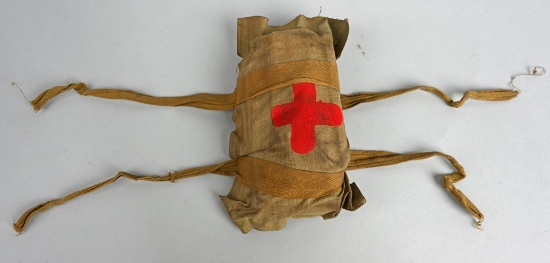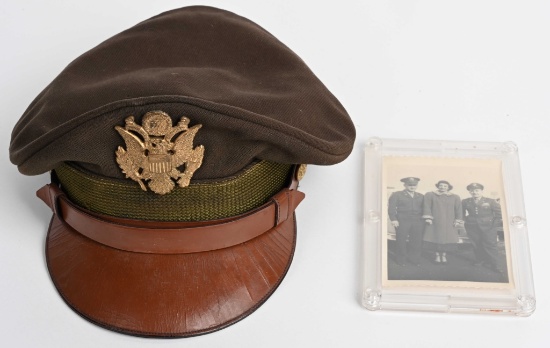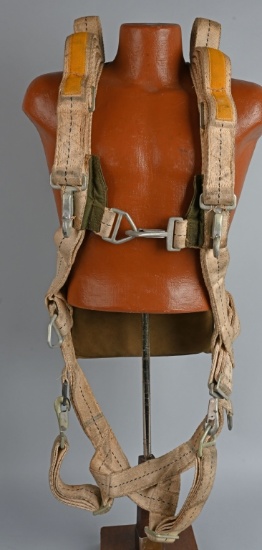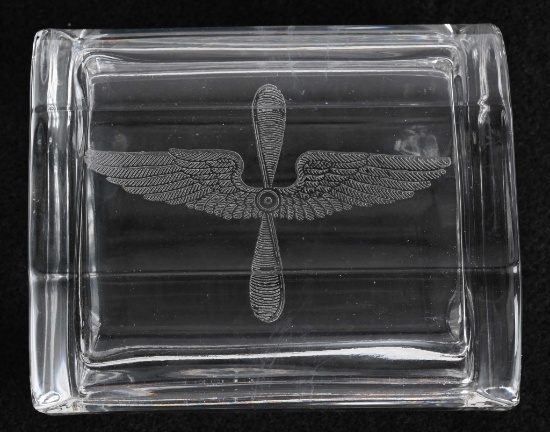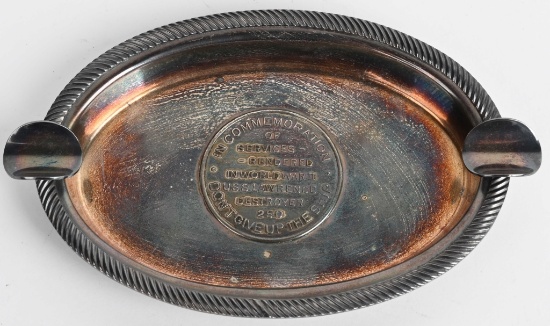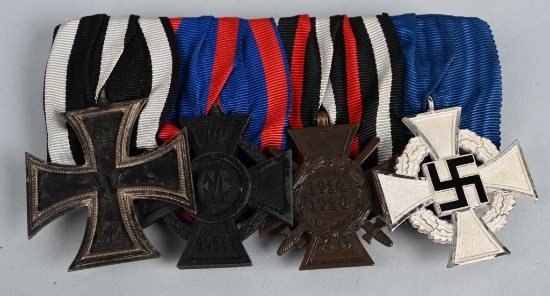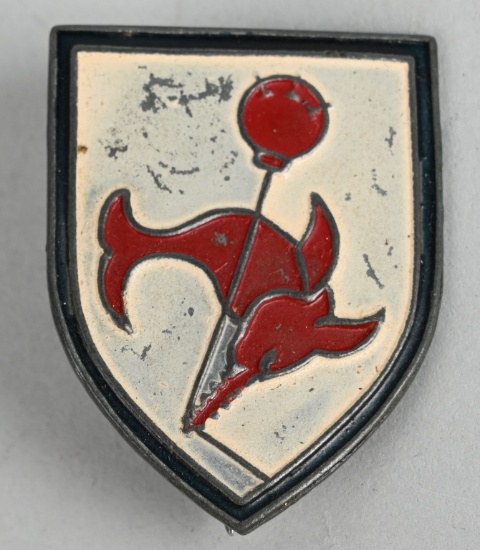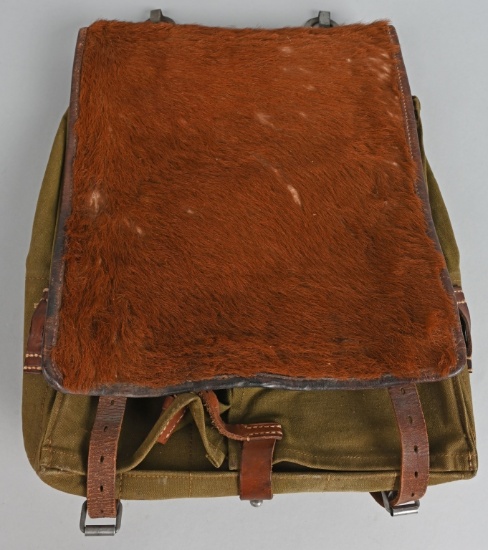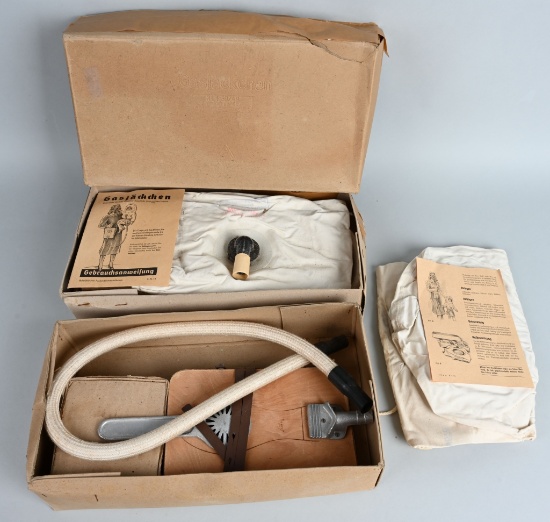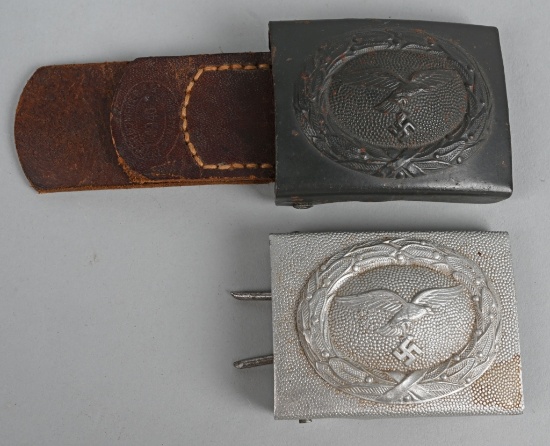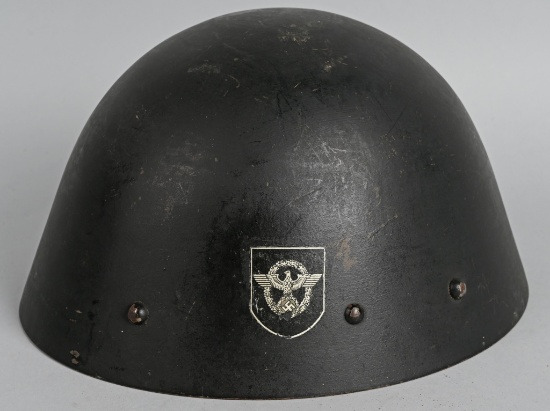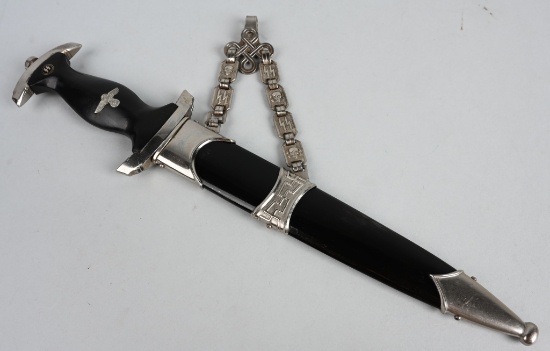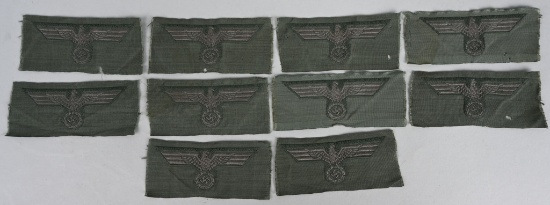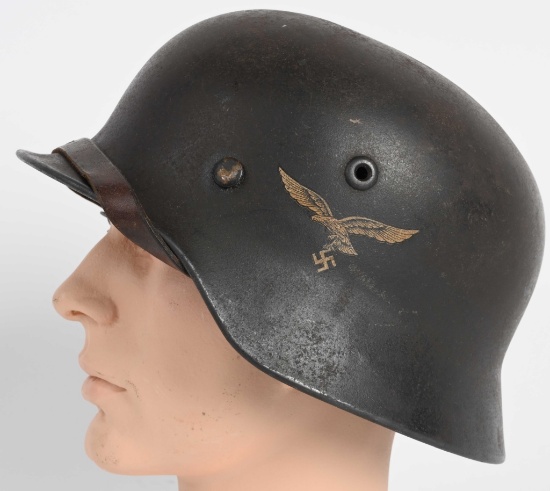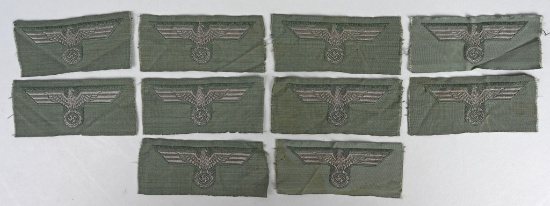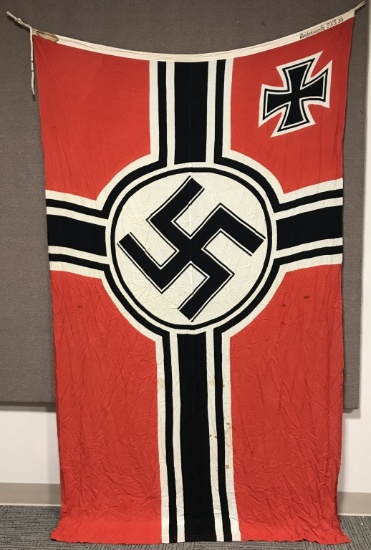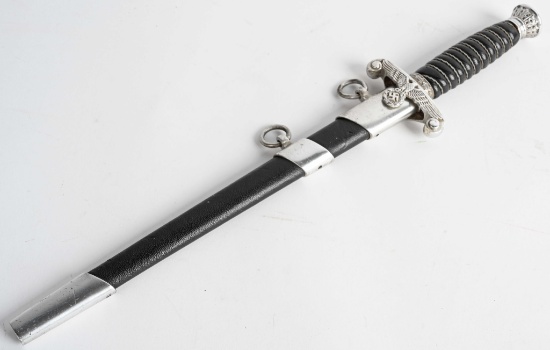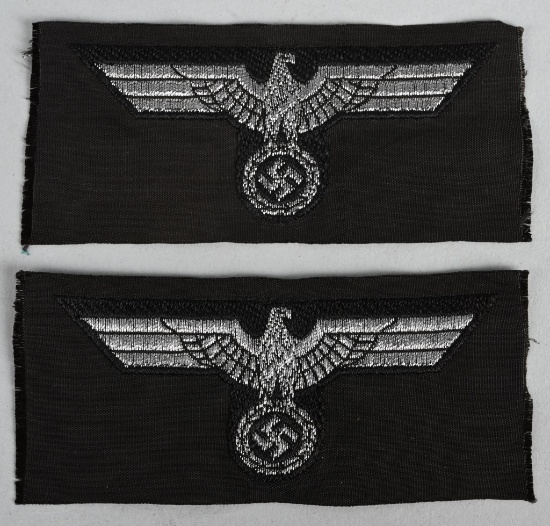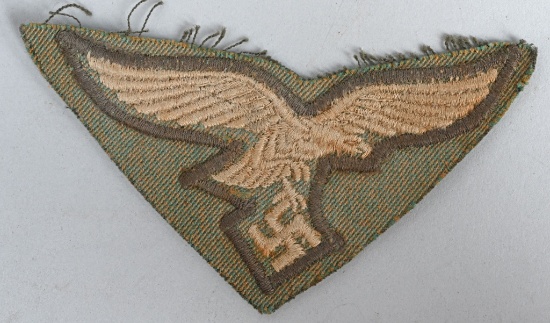Lot # 204 (Sale Order: 265 of 952)
Low Estimate: 6,000High Estimate: 7,000
M36 service dagger features a roughly, 8 5/8", (22 cm), long, double edged, nickel/silver plated, drop forged steel construction blade with a low central ridge and a full length, including the hilt, of roughly, 13 5/8", (34.7 cm). The nickel/silver plated blade shows light to scabbard runners . The obverse of the blade has a nice, well defined, Gothic scripted, acid etched motto, "Meine Ehre Heißt Treue", (My Honor is Loyalty). The blade has no manufacturer’s markings, as is correct. The dagger comes with a cast, solid, nickel/silver, construction cross guard, pommel and tang nut and a finely grained, carved, ebony grip. The nicely shaped ebony grip has a snug fit to the cross guard and pommel fittings. The grip has a flush, inset, die stamped, nickel/silver plated, national eagle with out-stretched wings, clutching a wreathed, canted, swastika in it’s talons and a nickel/silver plated and black enameled, runic SS button nicely fit in place. The dagger comes complete with a black anodized, magnetic, sheet metal scabbard with three, magnetic, nickel/silver fittings. The scabbard retains 98% of its original finish still with most of the lacquer. All three scabbard fittings retain both of their original, matching, small, dome headed retaining screws and the smooth, top fitting has an outwardly flared bottom edge and an integral, upward diagonally angled, chain suspension loop with a central, chain retaining cut-out. The central fitting features an embossed, scalloped lip, to both the top and bottom edges and embossed, stylized, conjoined swastika pattern to the center on a slightly textured, background field. The central fitting also has an integral, upward diagonally angled chain suspension loop with a central, chain retaining cut-out. The smooth, bottom scabbard fitting has an ovoid, ball tip to the bottom edge. The second pattern, non magnetic sheet metal suspension chain features two, six sided, rectangular links, four connecting loops and a cut-out, square link to the top section and four, six sided, rectangular links and five connecting loops to bottom section. The attachment links feature alternating, embossed skulls and crossbones and dual SS runes, with the top section having the skull closest to the cloverleaf and the runes closet to the scabbard while the bottom section is reversed with the dual SS runes closest to the cloverleaf and the skull and crossbones closest to the scabbard. All six links have smooth, raised, outer edges and a slightly textured background field. Both the top and bottom chains connect to a Celtic swirl "cloverleaf" design at the top edge with a soldered friction clip to the reverse. The Celtic cloverleaf has a central recessed line and three of the four circular interiors are cut-out with the top one being solid. The reverse of the second, top chain link, closest to scabbard, is well marked with the shallow, stamped, overlapping SS runes with an octagonal outer border. Shows minimal age, use and period wear, but overall near mint condition. Comes with an appraisal from militaria dealer Bill Shea evaluating the dagger and appraising the piece at 8295.00. The Allgemeine-SS, (General-SS), was originally formed in May 1923 as the Stosstrupp Adolf Hitler (Shock Troops, Adolf Hitler), and re-designated Schutz Staffel, (Protection Squad), in April 1925 with the official acceptance of the name verified on the second anniversary of the failed Munich "Beer-Hall" Putsch on November 9TH 1925. On January 6TH 1929 Heinrich Himmler was appointed as Reichsführer-SS, (National Leader of the SS), and on July 20TH 1934 shortly after the, June 30TH 1934, purge of the SA, Sturm Abteilung, (Storm/Assault Detachment), on the "Night of the Long Knives", the SS was rewarded by Hitler by being granted the status of an independent organization under direct control of the NSDAP, Nationalsozialistische Deutsche Arbeiterpartei, (National Socialist German Worker’s Party). The first dagger exclusively for SS personnel was the SS M33 service dagger which was introduced on December 15TH 1933 for wear by all, full, SS members, regardless of rank. The dagger was intended as an ornamental item and the design was based on the traditional 16TH century Swiss "Holbein" hunting dagger as was being utilized for the SA personnel’s dagger with a different coloration and insignia. The daggers were bestowed annually to newly accepted SS members at 10:00pm on the anniversary of the unsuccessful Beer Hall Putsch, (November 9TH), in front of the Feldherrnhalle, (Hall of Generals/Heros), in Munich. Originally the daggers featured an anodized scabbard and utilized nice quality, solid, nickel/silver fittings until roughly early 1937 when the scabbards began to have a painted finish and cheaper, nickel/silver plated fittings replaced the earlier, solid, nickel/silver fittings in 1938.
M36 service dagger features a roughly, 8 5/8", (22 cm), long, double edged, nickel/silver plated, drop forged steel construction blade with a low central ridge and a full
...more length, including the hilt, of roughly, 13 5/8", (34.7 cm). The nickel/silver plated blade shows light to scabbard runners . The obverse of the blade has a nice, well defined, Gothic scripted, acid etched motto, "Meine Ehre Heißt Treue", (My Honor is Loyalty). The blade has no manufacturer’s markings, as is correct. The dagger comes with a cast, solid, nickel/silver, construction cross guard, pommel and tang nut and a finely grained, carved, ebony grip. The nicely shaped ebony grip has a snug fit to the cross guard and pommel fittings. The grip has a flush, inset, die stamped, nickel/silver plated, national eagle with out-stretched wings, clutching a wreathed, canted, swastika in it’s talons and a nickel/silver plated and black enameled, runic SS button nicely fit in place. The dagger comes complete with a black anodized, magnetic, sheet metal scabbard with three, magnetic, nickel/silver fittings. The scabbard retains 98% of its original finish still with most of the lacquer. All three scabbard fittings retain both of their original, matching, small, dome headed retaining screws and the smooth, top fitting has an outwardly flared bottom edge and an integral, upward diagonally angled, chain suspension loop with a central, chain retaining cut-out. The central fitting features an embossed, scalloped lip, to both the top and bottom edges and embossed, stylized, conjoined swastika pattern to the center on a slightly textured, background field. The central fitting also has an integral, upward diagonally angled chain suspension loop with a central, chain retaining cut-out. The smooth, bottom scabbard fitting has an ovoid, ball tip to the bottom edge. The second pattern, non magnetic sheet metal suspension chain features two, six sided, rectangular links, four connecting loops and a cut-out, square link to the top section and four, six sided, rectangular links and five connecting loops to bottom section. The attachment links feature alternating, embossed skulls and crossbones and dual SS runes, with the top section having the skull closest to the cloverleaf and the runes closet to the scabbard while the bottom section is reversed with the dual SS runes closest to the cloverleaf and the skull and crossbones closest to the scabbard. All six links have smooth, raised, outer edges and a slightly textured background field. Both the top and bottom chains connect to a Celtic swirl "cloverleaf" design at the top edge with a soldered friction clip to the reverse. The Celtic cloverleaf has a central recessed line and three of the four circular interiors are cut-out with the top one being solid. The reverse of the second, top chain link, closest to scabbard, is well marked with the shallow, stamped, overlapping SS runes with an octagonal outer border. Shows minimal age, use and period wear, but overall near mint condition. Comes with an appraisal from militaria dealer Bill Shea evaluating the dagger and appraising the piece at 8295.00. The Allgemeine-SS, (General-SS), was originally formed in May 1923 as the Stosstrupp Adolf Hitler (Shock Troops, Adolf Hitler), and re-designated Schutz Staffel, (Protection Squad), in April 1925 with the official acceptance of the name verified on the second anniversary of the failed Munich "Beer-Hall" Putsch on November 9TH 1925. On January 6TH 1929 Heinrich Himmler was appointed as Reichsführer-SS, (National Leader of the SS), and on July 20TH 1934 shortly after the, June 30TH 1934, purge of the SA, Sturm Abteilung, (Storm/Assault Detachment), on the "Night of the Long Knives", the SS was rewarded by Hitler by being granted the status of an independent organization under direct control of the NSDAP, Nationalsozialistische Deutsche Arbeiterpartei, (National Socialist German Worker’s Party). The first dagger exclusively for SS personnel was the SS M33 service dagger which was introduced on December 15TH 1933 for wear by all, full, SS members, regardless of rank. The dagger was intended as an ornamental item and the design was based on the traditional 16TH century Swiss "Holbein" hunting dagger as was being utilized for the SA personnel’s dagger with a different coloration and insignia. The daggers were bestowed annually to newly accepted SS members at 10:00pm on the anniversary of the unsuccessful Beer Hall Putsch, (November 9TH), in front of the Feldherrnhalle, (Hall of Generals/Heros), in Munich. Originally the daggers featured an anodized scabbard and utilized nice quality, solid, nickel/silver fittings until roughly early 1937 when the scabbards began to have a painted finish and cheaper, nickel/silver plated fittings replaced the earlier, solid, nickel/silver fittings in 1938.less...
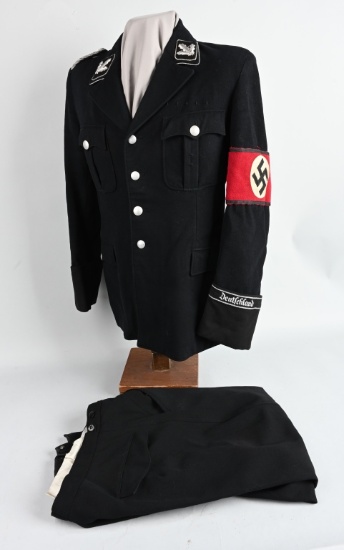


 x Cancel
x Cancel